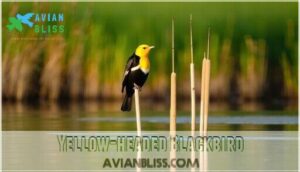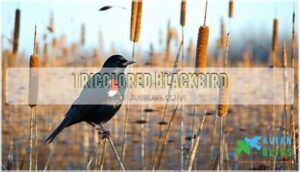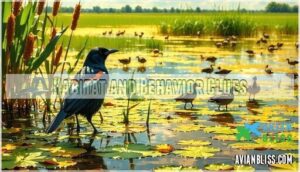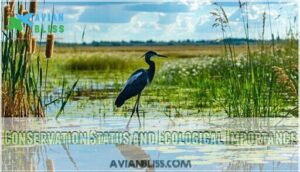This site is supported by our readers. We may earn a commission, at no cost to you, if you purchase through links.

Males display bright red shoulder patches bordered by distinctive white or yellow stripes, while females show more subtle streaked patterns.
These adaptable birds thrive in wetlands, marshes, and grasslands across the continent.
Other possibilities include the Yellow-headed Blackbird with bold white wing bars, or the compact Lark Bunting showing crisp white patches during breeding season.
Each species has unique habitat preferences and behavioral patterns that’ll help you nail down the exact identification.
Understanding their seasonal variations and regional distributions reveals fascinating migration secrets.
Table Of Contents
- Key Takeaways
- Common Black Birds With White-Striped Wings
- Identifying Features of White-Striped Wing Birds
- Habitats and Distribution of These Species
- Woodpeckers With Distinctive Wing Patterns
- Conservation Status and Ecological Importance
- Frequently Asked Questions (FAQs)
- What birds have white striped wings?
- What birds can confuse a blackbird with white stripes?
- What is a white winged widowbird?
- Why do birds have white stripes on their wings?
- Do black birds have white stripes on their wings?
- What is a red winged blackbird?
- What does it mean if you keep seeing a red-winged blackbird?
- Are Red-winged Blackbirds a nuisance?
- Is a grackle a blackbird?
- Is red-winged blackbird rare?
- Conclusion
Key Takeaways
- You’ll most likely spot a Red-winged Blackbird when you see a black bird with white wing stripes, as they’re North America’s most common species with these markings, though males show bright red shoulder patches while females display more subtle patterns.
- You can distinguish between similar species by observing their habitats – Yellow-headed Blackbirds prefer cattail marshes, Lark Buntings thrive in grasslands, and Tricolored Blackbirds stick to California’s wetlands.
- You’ll need to look beyond just wing patterns for accurate identification, paying attention to bill shape, body size, tail length, and distinctive behaviors like feeding habits and vocalizations.
- You’re witnessing important ecological players when you spot these birds, as they control crop-damaging insects, disperse seeds, and serve as environmental indicators, though some species face serious conservation challenges from habitat loss.
Common Black Birds With White-Striped Wings
You’ll encounter several black birds with prominent white wing stripes across North America, from the striking Yellow-headed Blackbird with its bright yellow head to the smaller Lark Bunting that shows off white patches during flight.
These species share the distinctive wing markings that make them easier to identify than you might expect, though each has unique features that help distinguish one from another in the field with distinctive characteristics.
Yellow-headed Blackbird
When you spot a Yellow-headed Blackbird with its distinctive white stripe on wing, you’re looking at nature’s most dramatic dresser.
These black birds make wetland dependence their lifestyle, building nests over water in cattail marshes.
Here’s what makes this bird species unique for bird identification:
- Breeding Habits: Males arrive first to claim prime marsh territory
- Vocalizations: Harsh, rusty-gate calls that carry across wetlands
- Diet: Insects, seeds, and aquatic invertebrates
- Plumage Variation: Females show duller yellow heads
- Wetland Dependence: Requires cattail marshes for successful nesting
Tricolored Blackbird
California’s Tricolored Blackbird stands out with its distinctive red shoulder patch and white stripe on dark wings.
This California endemic practices colony nesting in massive groups, creating one of nature’s most impressive spectacles.
Unfortunately, this black bird faces serious challenges:
- Heartbreak over dramatic population decline since the 1930s
- Anxiety about habitat loss threatening their survival
- Hope through dedicated conservation efforts showing promise
Bird identification becomes easier when you spot their unique wing markings.
This bird species represents both California’s natural heritage and conservation success stories in progress.
Habitat loss is a significant threat, requiring habitat preservation efforts for their continued survival.
Lark Bunting
Meet the Lark Bunting, Colorado’s state bird that showcases dramatic sexual dimorphism. During breeding season, males transform into sleek black birds with bold white stripes across their wings, while females maintain subtle brown plumage with streaked patterns.
This grassland bird thrives in prairie environments, but faces challenges from habitat loss as agricultural development expands. You’ll spot these remarkable bird species performing aerial courtship displays, where males sing while fluttering overhead.
Their migration patterns take them from northern breeding grounds to southern wintering areas, making bird identification seasonal. They’re prairie pest controllers, devouring grasshoppers during summer months.
| Feature | Male | Female |
|---|---|---|
| Breeding Color | Jet black | Streaked brown |
| Wing Pattern | White patches | Faint stripes |
| Size | 6.5 inches | 6 inches |
| Bill Shape | Thick, conical | Thick, conical |
| Habitat | Open grasslands | Open grasslands |
Identifying Features of White-Striped Wing Birds
You’ll notice that identifying black birds with white wing stripes requires looking beyond just the obvious markings, since these species vary substantially in size, bill shape, and overall body proportions.
The key lies in observing how the white stripes appear during flight versus when perched, along with noting the bird’s habitat preferences and distinctive behaviors that often prove more reliable than color patterns alone, which can be considered a key aspect of identification, and understanding these behaviors is critical.
Distinctive Wing Patterns
When observing Wing Morphology, you’ll notice these distinctive patterns aren’t random accidents of nature. Flight Dynamics actually influence how white stripes appear during wing movement, creating stunning visual displays.
These markings serve multiple purposes beyond simple bird identification features:
- Camouflage – White stripes break up the bird’s silhouette against dappled sunlight
- Species Variation – Each black bird displays unique stripe width and positioning
- Pattern Evolution – These white stripe designs developed over thousands of years for survival advantages
Understanding these identification clues transforms casual birdwatching into detective work.
Size and Shape Variation
Comparing bird size helps you nail down identifications when you spot that black bird with white stripe on wings.
Sexual dimorphism means males often outsize females, while bill morphology varies from thin warbler beaks to sturdy woodpecker chisels.
Wing shape and tail length differ dramatically—compare a compact Lark Bunting’s wingspan to a lengthy magpie’s flowing tail and greater body mass.
Identifying birds also relies on observing their plumage and coloration, which is crucial for accurate identification and understanding sexual dimorphism and plumage patterns.
Habitat and Behavior Clues
Where you spot these birds tells a story about their lives.
Yellow-headed blackbirds stick to wetlands with cattails, while lark buntings prefer open grasslands.
Watch their feeding behavior – mockingbirds hunt insects on lawns, but tricolored blackbirds form massive flocks in agricultural areas.
Listen for their vocalizations too; each species has distinct calls that help with bird identification in dense vegetation.
Understanding avian environment needs can further refine identification, especially in terms of avian environment.
Habitats and Distribution of These Species
You’ll find these striking black birds with white wing stripes across remarkably diverse environments, from North America’s prairie grasslands and wetland marshes to Europe’s temperate woodlands and Asia’s scattered forest edges.
Understanding where each species calls home will help you narrow down your identification when you spot that telltale flash of white against dark feathers during your next birding adventure.
This will aid in recognizing the diverse environments they inhabit.
North American Regions
Finding these distinctive black bird species across North America requires knowing their Regional Variations and Habitat Preferences.
Here’s your bird identification guide for locating each species:
- Black-billed Magpies inhabit western regions from Alaska through Rocky Mountain states
- Lark Buntings prefer prairie territories across central United States and Canada
- Tricolored Blackbirds stick to west coast areas from California to Baja Mexico
- Yellow-headed Blackbirds frequent western marshlands and wetland Breeding Grounds
- Brewer’s Blackbirds range throughout most United States and southwestern Canada
These magpies are actually more closely related to yellow-billed magpies than Eurasian magpies.
Migration Patterns shift these distributions seasonally, so you’ll spot different species depending on timing.
Conservation Efforts help maintain their traditional ranges despite habitat changes.
Global Locations
Beyond North America’s borders, you’ll discover these black bird species with white stripe markings across surprising Global Habitats.
Regional Variations adapt to local conditions while maintaining distinctive wing patterns.
| Species | Primary Range | Notable Features |
|---|---|---|
| Eurasian Magpie | Europe to Eastern Asia | White shoulder patches, intelligent behavior |
| White-browed Wagtail | Indian Subcontinent | Broad white wing bars, territorial nature |
| White-winged Chough | Eastern Australia | Social flocks, cooperative breeding |
| Magpie-lark | Australia-wide | Black and white contrast, urban adaptation |
| Oriental Magpie-Robin | Southeast Asia | Migration Patterns vary by region |
For more information on these birds, you can explore the global bird products.
Conservation Efforts protect these diverse bird species worldwide, ensuring their bird distribution remains stable across continents.
Woodpeckers With Distinctive Wing Patterns
You’ll find that several woodpecker species display striking black bodies with distinctive white wing stripes, making them easier to identify than you might expect when they’re clinging to tree trunks or flying between branches.
These drum-loving carpenters of the forest, including the White-headed Woodpecker, Hairy Woodpecker, and Downy Woodpecker, each show unique combinations of black plumage and white markings that’ll help you distinguish one species from another during your backyard birdwatching adventures, which can be a very rewarding experience.
White-headed Woodpecker
The White-headed Woodpecker breaks the mold among black birds with white stripe patterns. This remarkable woodpecker species flips the script with its snow-white head contrasting against jet-black wings and body. Males sport a brilliant red nape patch that catches sunlight like a tiny flame.
Habitat Preference centers on old-growth pine forests throughout the Pacific Northwest. Diet Details reveal these woodpeckers prefer pine seeds over insects, making them unique specialists. Like other woodpeckers, they nest in tree cavities.
- Watch them gracefully scale towering ponderosa pines like feathered acrobats
- Listen for their gentle tapping, softer than hammering nails
- Marvel at their cone-opening technique, delicate yet efficient
- Appreciate their Conservation Efforts protecting ancient forest ecosystems
Hairy Woodpecker
Moving from the White-headed Woodpecker’s pine forests, you’ll encounter the Hairy Woodpecker across diverse North American habitats.
This black bird displays prominent white stripes on its wings, making bird identification straightforward for woodpecker enthusiasts.
Hairy vs Downy comparisons reveal the Hairy’s larger size and longer bill.
You’ll hear their sharp "peek" calls and rhythmic drumming communication echoing through forests.
| Feature | Details |
|---|---|
| Hairy Diet | Wood-boring insects, beetle larvae |
| Nesting Habits | Excavates cavities 6-60 feet high |
| Size | 7-10 inches, larger than Downy |
| Habitat | Mixed forests, parks, backyards |
| Conservation Concerns | Stable populations, habitat-dependent |
Their powerful bills extract insects from deep bark crevices, while stiff tail feathers provide essential support during vertical climbs.
Downy Woodpecker
At just 6 inches tall, the Downy Woodpecker is North America’s smallest woodpecker with striking checkered black and white wing patterns.
You’ll easily distinguish males by their red nape patch, while females lack this marking.
Their Downy diet includes insects, seeds, and suet from backyard feeders.
Nesting habits involve excavating cavities in dead wood.
This black bird with white stripe markings frequents suburban yards, making bird identification simple for beginners.
Conservation Status and Ecological Importance
After admiring these remarkable woodpeckers, you might wonder how these black birds with distinctive wing stripes are faring in today’s world. Unfortunately, several species face serious challenges that threaten their survival.
These striking black birds with white wing stripes face an uncertain future in our rapidly changing world.
Population Trends reveal concerning declines. The Lark Bunting has experienced significant drops due to grassland conversion, while some endangered species like the Tricolored Blackbird teeter on the brink with fewer than 200,000 individuals remaining. Understanding a species’ bird conservation status is essential for prioritizing protection efforts.
These birds serve vital Ecosystem Role functions that ripple through entire food webs:
- Pest control specialists – consuming thousands of crop-damaging insects annually, saving farmers millions in pesticide costs
- Seed dispersal agents – spreading native plant species across landscapes through their droppings and cached food stores
- Indicator species – their population health reflects overall environmental conditions in wetlands and grasslands
Habitat Preservation remains the cornerstone of Conservation Efforts. Supporting organizations that protect wetlands and grasslands directly impacts these species’ survival. Their ecological importance extends far beyond their striking appearance – they’re environmental guardians whose conservation benefits entire ecosystems.
Frequently Asked Questions (FAQs)
What birds have white striped wings?
Ever wonder which feathered friends sport those striking white wing stripes?
You’ll spot Northern Mockingbirds, Lark Buntings, Yellow-headed Blackbirds, and various woodpeckers like Downys and Hairys displaying these distinctive white markings during flight.
They include woodpeckers like Downys and Hairys.
What birds can confuse a blackbird with white stripes?
You’ll often mistake Red-winged Blackbirds, Tricolored Blackbirds, and Lark Buntings for true blackbirds with white stripes.
Northern Mockingbirds and various woodpeckers also share similar black-and-white wing patterns that can fool you, making it important to note the differences to accurately identify true blackbirds.
What is a white winged widowbird?
Don’t judge a book by its cover—you’ll find the white-winged widowbird is an African species.
Males display dramatic black plumage with white wing patches during breeding season, contrasting sharply with their brownish non-breeding appearance.
Why do birds have white stripes on their wings?
Birds display white wing stripes for multiple reasons: they’re visual signals for communication, help with species recognition during mating, serve as territorial markers, and can confuse predators during flight escapes.
Do black birds have white stripes on their wings?
Yes, you’ll spot several black birds sporting white wing stripes.
Northern Mockingbirds, Yellow-headed Blackbirds, and various woodpeckers like the Downy display these striking markings that help with identification and bird communication.
What is a red winged blackbird?
The red-winged blackbird displays striking red shoulder patches with yellow borders on males.
You’ll spot them in wetlands, marshes, and cattails across North America, where they’re among our most recognizable songbirds.
What does it mean if you keep seeing a red-winged blackbird?
When life keeps throwing the same bird your way, you’re likely witnessing territorial behavior.
Red-winged blackbirds defend their turf aggressively, so you’re probably near their nesting area or favorite food source.
Are Red-winged Blackbirds a nuisance?
Red-winged blackbirds can become troublesome when they’re defending territory during breeding season.
They’ll aggressively dive-bomb people near their nests, but they’re generally beneficial for controlling insects and aren’t considered major pests.
Is a grackle a blackbird?
Grackles belong to the blackbird family, making them true blackbirds.
They’re larger than most blackbirds with distinctive yellow eyes.
You’ll recognize them by their iridescent feathers that shimmer purple, blue, or green.
Is red-winged blackbird rare?
Like a common sparrow in your neighborhood, you’ll spot red-winged blackbirds everywhere they belong.
They’re not rare at all—these adaptable birds thrive across North America’s wetlands, making them one of our most abundant species, with red-winged blackbirds being a common sight.
Conclusion
Spotting a black bird with white stripe on wing becomes as straightforward as following breadcrumbs once you’ve mastered these identification techniques.
You’ll confidently distinguish Red-winged Blackbirds from Yellow-headed Blackbirds, recognize seasonal plumage changes, and understand habitat preferences.
Remember to observe wing patterns, size differences, and behavioral cues for accurate identification.
Whether you’re exploring wetlands or grasslands, these distinctive markings make each black bird with white stripe on wing species unmistakable with proper observation skills.












